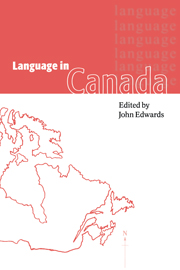Book contents
- Frontmatter
- Contents
- List of figures
- List of maps
- List of tables
- Notes on contributors
- 1 Canada
- Introduction
- 1 The foundations
- 2 The fading Canadian duality
- 3 Official bilingualism: from the 1960s to the 1990s
- 4 Official multiculturalism
- 5 Language in education: bridging educational policy and social psychological research
- 6 Aboriginal languages: history
- 7 Aboriginal languages: current status
- 8 French: Canadian varieties
- 9 French in Quebec
- 10 French in New Brunswick
- 11 French outside New Brunswick and Quebec
- 12 English: Canadian varieties
- 13 English Quebec
- 14 The teaching of international languages
- 15 French immersion in Canada
- 16 Language in Newfoundland
- 17 Language in Prince Edward Island
- 18 Language in Nova Scotia
- 19 Language in New Brunswick
- 20 Language in Quebec: aboriginal and heritage varieties
- 21 Language in Ontario
- 22 Language in Manitoba
- 23 Language in Saskatchewan: Anglo-hegemony maintained
- 24 Language in Alberta: unilingualism in practice
- 25 Language in British Columbia
- 26 Language in the Northwest Territories and the Yukon Territory
- Index of names
- Index of language families, languages, dialects
- Index of subjects
12 - English: Canadian varieties
Published online by Cambridge University Press: 18 February 2010
- Frontmatter
- Contents
- List of figures
- List of maps
- List of tables
- Notes on contributors
- 1 Canada
- Introduction
- 1 The foundations
- 2 The fading Canadian duality
- 3 Official bilingualism: from the 1960s to the 1990s
- 4 Official multiculturalism
- 5 Language in education: bridging educational policy and social psychological research
- 6 Aboriginal languages: history
- 7 Aboriginal languages: current status
- 8 French: Canadian varieties
- 9 French in Quebec
- 10 French in New Brunswick
- 11 French outside New Brunswick and Quebec
- 12 English: Canadian varieties
- 13 English Quebec
- 14 The teaching of international languages
- 15 French immersion in Canada
- 16 Language in Newfoundland
- 17 Language in Prince Edward Island
- 18 Language in Nova Scotia
- 19 Language in New Brunswick
- 20 Language in Quebec: aboriginal and heritage varieties
- 21 Language in Ontario
- 22 Language in Manitoba
- 23 Language in Saskatchewan: Anglo-hegemony maintained
- 24 Language in Alberta: unilingualism in practice
- 25 Language in British Columbia
- 26 Language in the Northwest Territories and the Yukon Territory
- Index of names
- Index of language families, languages, dialects
- Index of subjects
Summary
The sociology of Canadian English (CE), though far from simple, is readily comprehensible. This is perhaps surprising, given the vast territory of Canada, the linguistic complexity of a nation with two official languages, and the diverse ethnicity of the anglophone population. But these complex conditions have mitigating adjuncts. In land mass, Canada occupies more space than any other nation save Russia, but the population of about 27,300,000 (in the 1991 census, according to Statistics Canada, 1992, 1993, the source of all current statistics in this chapter) is relatively compact, largely concentrated in cities or towns, mainly in a long, narrow band within 200 kilometers of the Canada–US border. Of the official languages, English predominates with about 63 per cent speaking English and another 13 per cent admitting to neither official language but who are largely speakers of English as a second language (ESL); outside Quebec, the francophone heartland, about 95 per cent speak English (including ESL). The ethnic diversity of the anglophone population is almost entirely the result of immigrations in this century, but the earlier immigrations – the ones that supplied the formative anglophone influences linguistically and in numerous other ways, as we will see below – were ethnically homogeneous; only now is ethnic diversity beginning to affect our native accents.
- Type
- Chapter
- Information
- Language in Canada , pp. 252 - 272Publisher: Cambridge University PressPrint publication year: 1998
- 21
- Cited by



